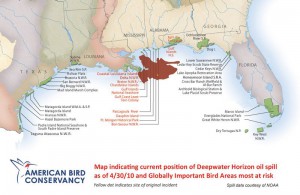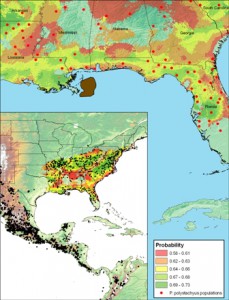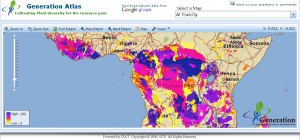The May 2010 Diversity and Distributions is a special issue on “Conservation biogeography — foundations, concepts and challenges.” I haven’t had a chance to go through it all, but there are very interesting-looking contributions on how to improve niche model, the role of citizen science and the biogeography of climate change. More when I actually read a couple of the papers.
Nibbles: Mapping islands, Palm diversity, Niche models
- A Global Island Database for all you GIS geeks.
- African palms threatened by climate change: sensitive to climate, but constrained in their movement.
- But careful, it is easy to overestimate extinction risk when playing around with climate suitability models.
Gulf oil spill not much of a threat to one crop wild relative
The Gulf oil spill is threatening some Globally Important Bird Areas, according to the LA Times:
And other protected areas too. Unfortunately, we don’t have a similar map for crop wild relatives, at least not just yet, at least not so easily available. So it’s hard to estimate the overall threat posed by the oil spill on these genetic resources — which are arguably of greater importance than most birds, but there you go. What we can do — just about — is look at the distribution of individual species. And that is what our friend Julian at CIAT has done for a wild bean, Phaseolus polystachyus.
Not in any particular danger, though one or two coastal populations may be affected, I suppose. But I just wonder if one day the LA Times will publish a map showing the Globally Important Crop Wild Relative Areas threatened by some calamity or other.
Farming systems atlas taking shape
Our friends at CIAT are putting together a lot of geo-referenced data on farming systems around the world. Check out in particular what they call the Generation Atlas. Below is a screen shot of a detail of the map of the distribution of aluminium toxicity in Africa.
Somebody somewhere is probably working on mashing this up with the germplasm data from SINGER or even the crop wild relatives data from GBIF, a la FIGS.
Nibbles: Recognizing breeds, Cannabis in New Zealand, Farming systems data, Maize inbreds, Zinc in wheat, Markets for nature, Ramie, Milk and drought, ELBARN
- Computer program recognizes cattle breeds.
- NZ dope getting stronger? Maybe, and I hope so, but probably impossible to tell from this study.
- Need farming systems data?
- Psst, wanna know how to determine the essentially derived status of maize inbred lines?
- High zinc wheat works.
- Michael Jenkins of Forests Trends on using markets to save biodiversity.
- The phylogeny of ramie and its wild relatives sorted out. Sort of.
- Pearl millet landraces are the best under drought.
- Area action plans for local breeds in Europe are out.


